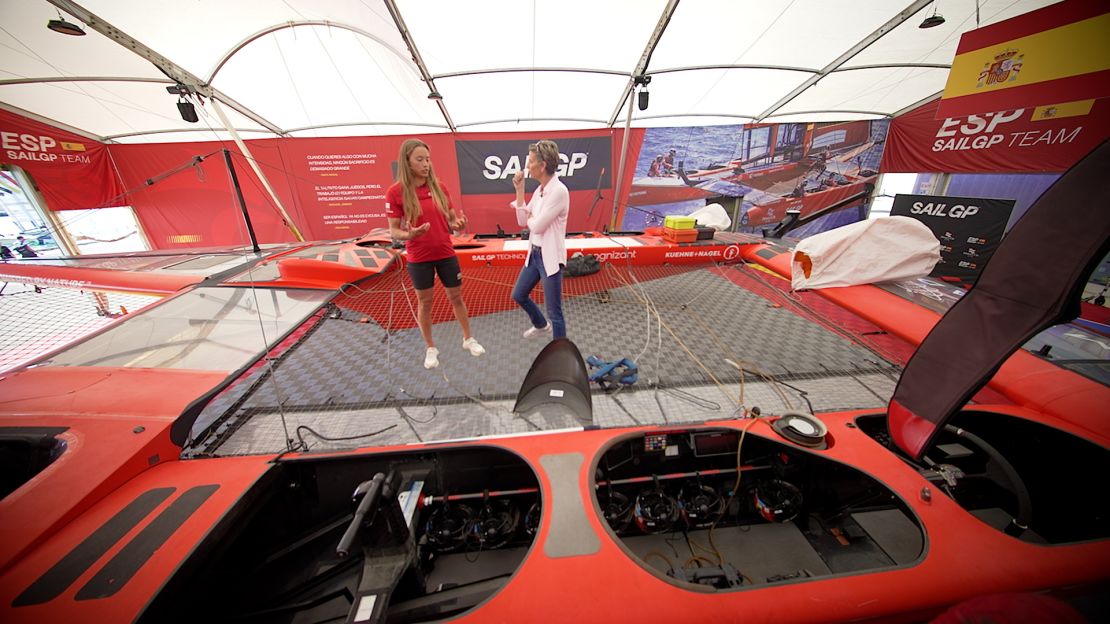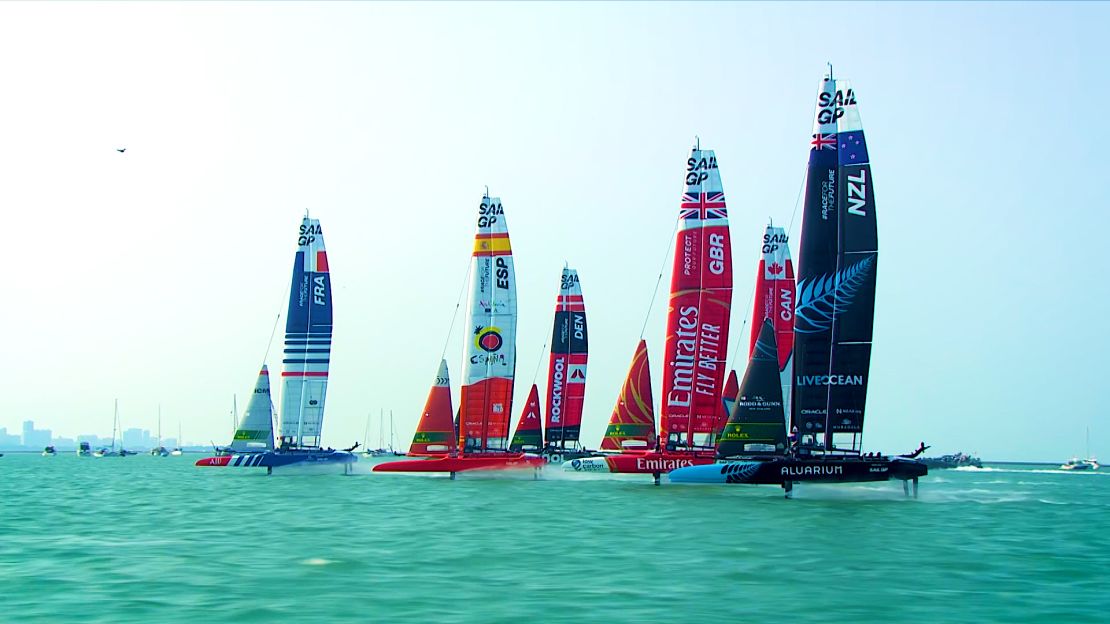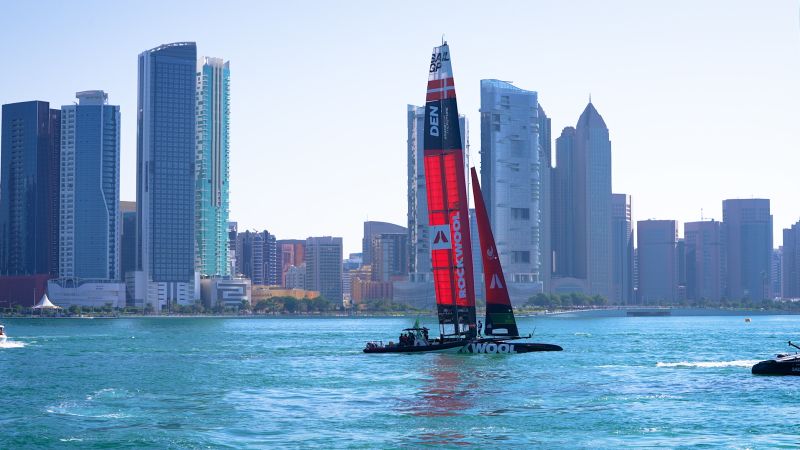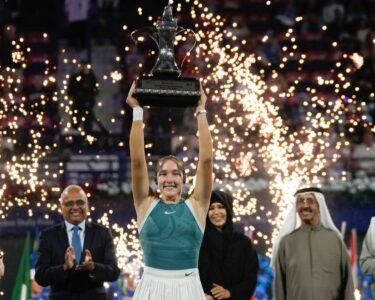CNN
—
Balanced on the side of one hull, New Zealand’s black catamaran glides over the finish line at the deep-water Zayed Port, its 29-meter-long carbon fiber wing stiff in the sea breeze.
Just meters away, a grandstand with thousands of spectators erupts in excited cheers, as the Kiwis take their second win in the Persian Gulf in a matter of weeks.
When you think of race weekends in Abu Dhabi, Formula One comes to mind. But now there is a new sport in the United Arab Emirates’ capital – SailGP.
The Mubadala Abu Dhabi Sail Grand Prix is new to the global 13-race calendar. Presented by the Abu Dhabi Sports Council, it’s advertised as two days of winner-takes-all adrenaline-fueled racing, with crews aiming to pick up points to add to those accumulated already at races in cities such as San Francisco and Sydney.
“It’s all about really making it a better race, and a better entertainment spectacle,” SailGP’s chief Russell Coutts recently told CNN’s Becky Anderson, ahead of the race in Abu Dhabi.
Coutts is one of the biggest names in sailing and before becoming the brainchild of SailGP, he was a five-time America’s Cup winner and multiple world champion, also winning a gold medal for New Zealand at the 1984 Olympics.
He’s hoping the enormous F50 catamarans will be a big draw for new fans. They can reach speeds of nearly 100 km/h (62m/h), sending 300,000 data points every second through 5G routers so that teams can analyze their movements in real time.
The quays at Zayed Port were occupied by two large cranes tasked with winching the boats onto the water. During races, sailors appear ant-sized to spectators, crawling over the hulls or being pinned down to the craft by the G-force.
“This is really a whole new dimension,” Coutts said. “And the moment that the boats got out of the water and on foils, and started to go so fast, I think that really spiked the interest of a much wider group of people.”

But they don’t come cheap, costing around $5 million to build, with extra costs in the millions to manage teams and logistics on top of that. A record 1.78 million viewers in the United States tuned into the Spain leg of the championship, but for the sport to survive, expanding and bringing in even newer audiences is vital.
“Well, our audience, if you compare season two to season three, our broadcast audience grew three times through our dedicated viewership,” said Coutts. “So the team’s values are growing enormously as well. The latest team sold for $35 million.”
The sale of the US team is reportedly well above a $40 million valuation.
It’s not just about making the races fast and furious. Coutts is also bringing in other forms of entertainment – English pop group Take That was the star headliner in Abu Dhabi.
“It’s been elitist, and we wanted to break down all of those barriers, and really bring it closer to the people, and provide more entertainment around our racing,” Coutts added.
“So, our racing’s a short format packaged into a 90-minute broadcast window.”

Sailing to sustainability
The F50 catamarans don’t just float; they fly.
“Foiling is actually combining a bit like flying to the sailing sport,” explained Nicole van der Velden, a member of the Spanish crew, while giving CNN a tour of the team’s hangar.
“So it’s the same concept as an airplane, as an airplane wing. The water, when it moves through the foil, it creates a difference in speed, going above and below the same as an airplane wing.”
The sailing weight of the catamarans is 2.4 tons, and the wings can stretch to 29 meters. Moving them from site to site is a huge operation, while marine life can also be disturbed when setting up the races.
The series’ carbon footprint last year, including travelling fans, was the equivalent of 79,786 tonnes of carbon dioxide; for context, Formula One emitted roughly 256,000 tonnes in 2019.
The majority of SailGP’s footprint is not entirely in its control, being made up of supply chain logistics and fan travel, posing a challenge to Coutts.
“Out remote television production, or our remote umpiring, or our remote race management … It means that less people have to travel to these events,” he said.
“It’s more cost effective, it creates a better solution for the environment and a better product for the fan.”
Coutts has also set up an Impact League, where teams a awarded points based on sustainability and inclusivity efforts.
“So basically, it’s helping youngsters evolving in the sports, to having a cleaner environment, having a smaller carbon footprint, using solar energy, wind energy to power up everything that we need as well. So yeah, the league is trying to really take a step further in that,” said Van der Velden.

Abu Dhabi’s maritime heritage
The UAEs’ culture is rich in maritime heritage – pearl diving was once the driving force of the economy, and fishing is a firmly embedded tradition.
Now, silhouetted by the city’s skyline, fans pack glittering grandstands, just meters away from modern racing boats, making the event a clear draw for Mubadala, an Abu Dhabi sovereign wealth fund; a new partner in the global sailing series.
“25% of our portfolio sits in Abu Dhabi. This is a geography that is important for us,” Homaid Al Shimmari, deputy CEO of Mubadala, told CNN.
“It brings back a bit of the culture that we had … Heritage is there, but then you bring SailGP with all of these technologies.”
Bringing another high-profile sporting event to Abu Dhabi is not the only ambition for Mubadala.
“This is not about the race and about the teams and about the championship,” said Al Shimarri. “It’s about how can we get the younger generation to be interested in sailing and how to make it more inclusive?”
SailGP’s Inspire program, which aims to bring young participants into the sport without any barrier to entry, has already engaged nearly 16,000 people. Mubadala has also partnered with SailGP to help promote STEM education and sport within Inspire.
“We have almost 1,200 kids sitting in Abu Dhabi Sports Club for a whole week being excited about this,” said Al Shimarri.
“We have students from NYU, New York, four of them to come and spend the whole week working with the SailGP … to entice the next generations who are interested in science, STEM, latest technologies, and then bring it to this wonderful, comfortable city that we love.”

The sport can be dominated by men, and SailGP is no different, with no female drivers on their boats. In its inaugural year, there were no women involved, but this changed after the inclusion of a requirement for teams to have at least one female member aboard.
It’s part of SailGP’s commitment to promote inclusivity through its Women’s Pathway program.
“Our objective, and I hope we’re going to see this by season six, maybe even season five, is to not only have a woman driver racing in this league, but hopefully a woman driver that’s capable of winning this league,” said Coutts, when asked about the issues around inclusivity.
Van der Velden is the only female member of the Spanish crew and works as a strategist, which involves her supplying information that the rest of the crew uses to make best use of the weather conditions and route. All the female SailGP athletes on six-person crews occupy this role, but some hope to one day be the drivers.
The sailors were tested by challenging light winds in Abu Dhabi, where Van der Velden and Spain finished runners-up behind the dominant New Zealand team. The Kiwis are closing the gap on three-time champions Australia at the top of the leaderboard, with a United States team led by seven-time world champion, Taylor Canfield, in third.
For Coutts and those working on land, it’s all hands-on deck to pursue the bigger picture. The burgeoning new sport is attempting to make waves but must still attract the large audiences it needs to thrive, while lowering its carbon footprint to meet its lofty goals.






